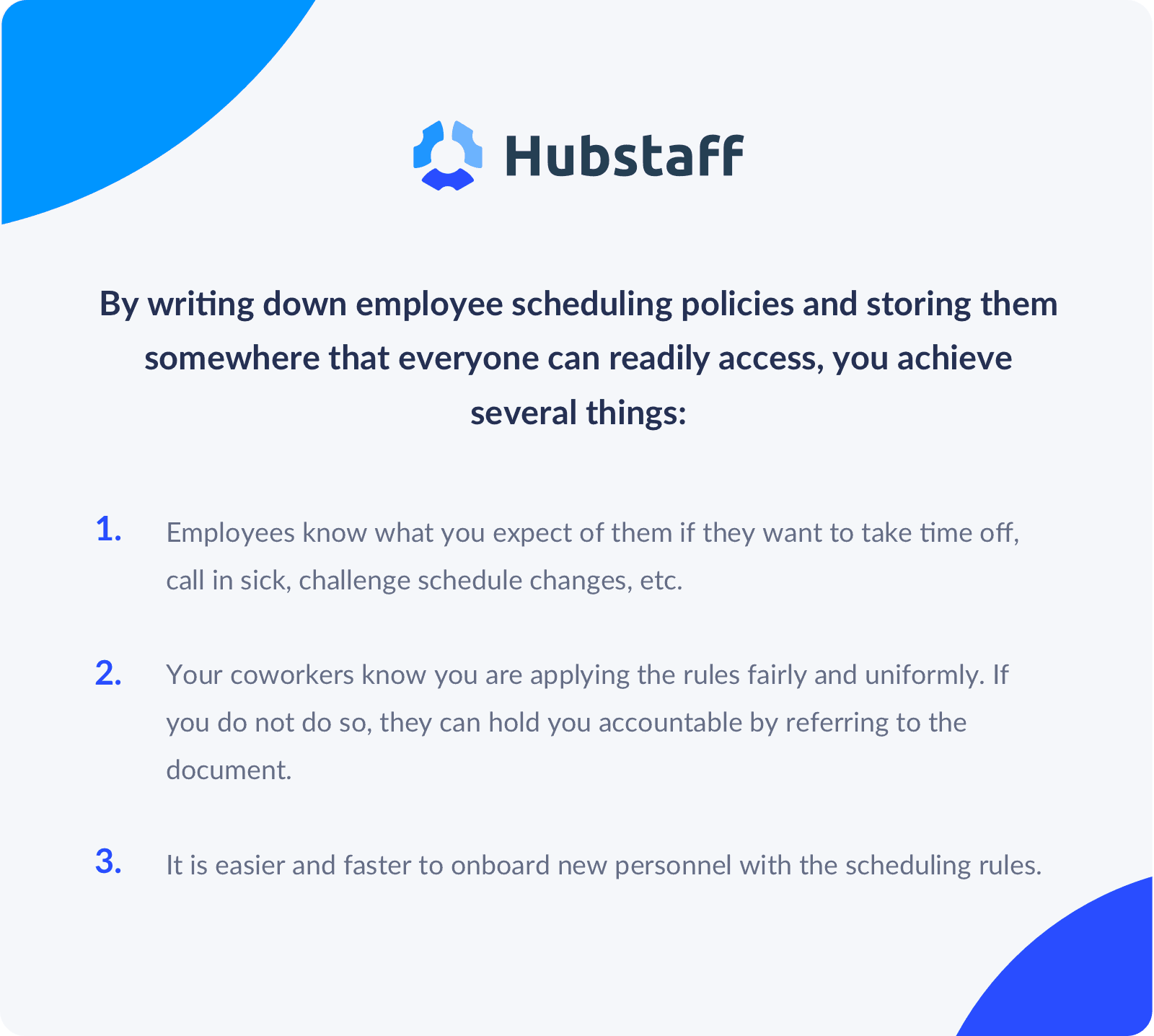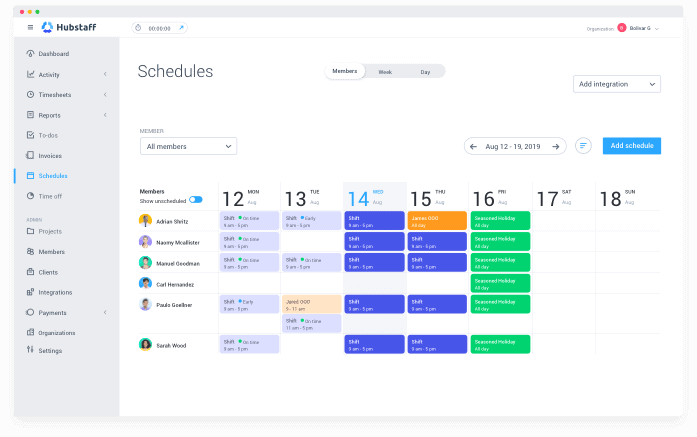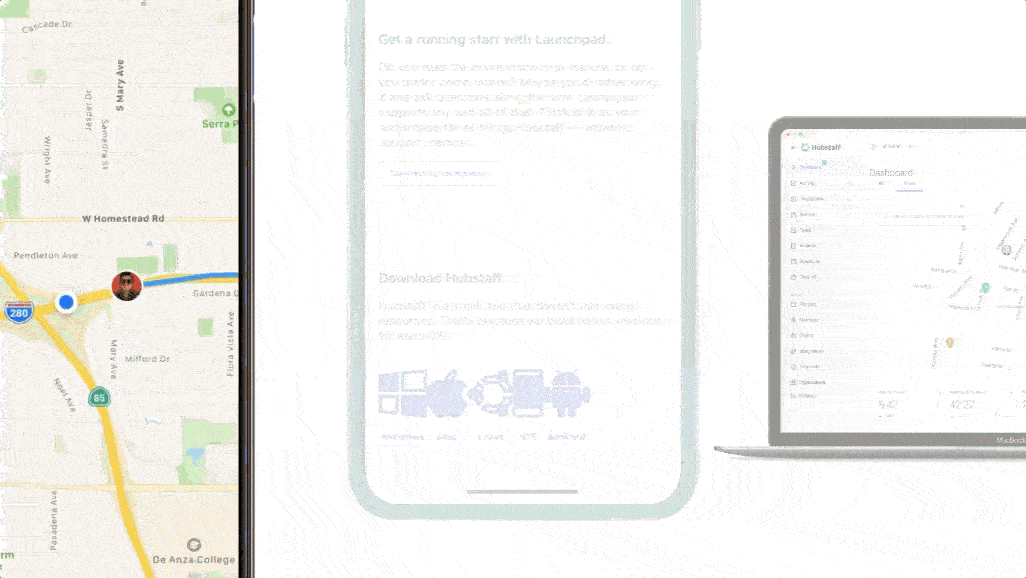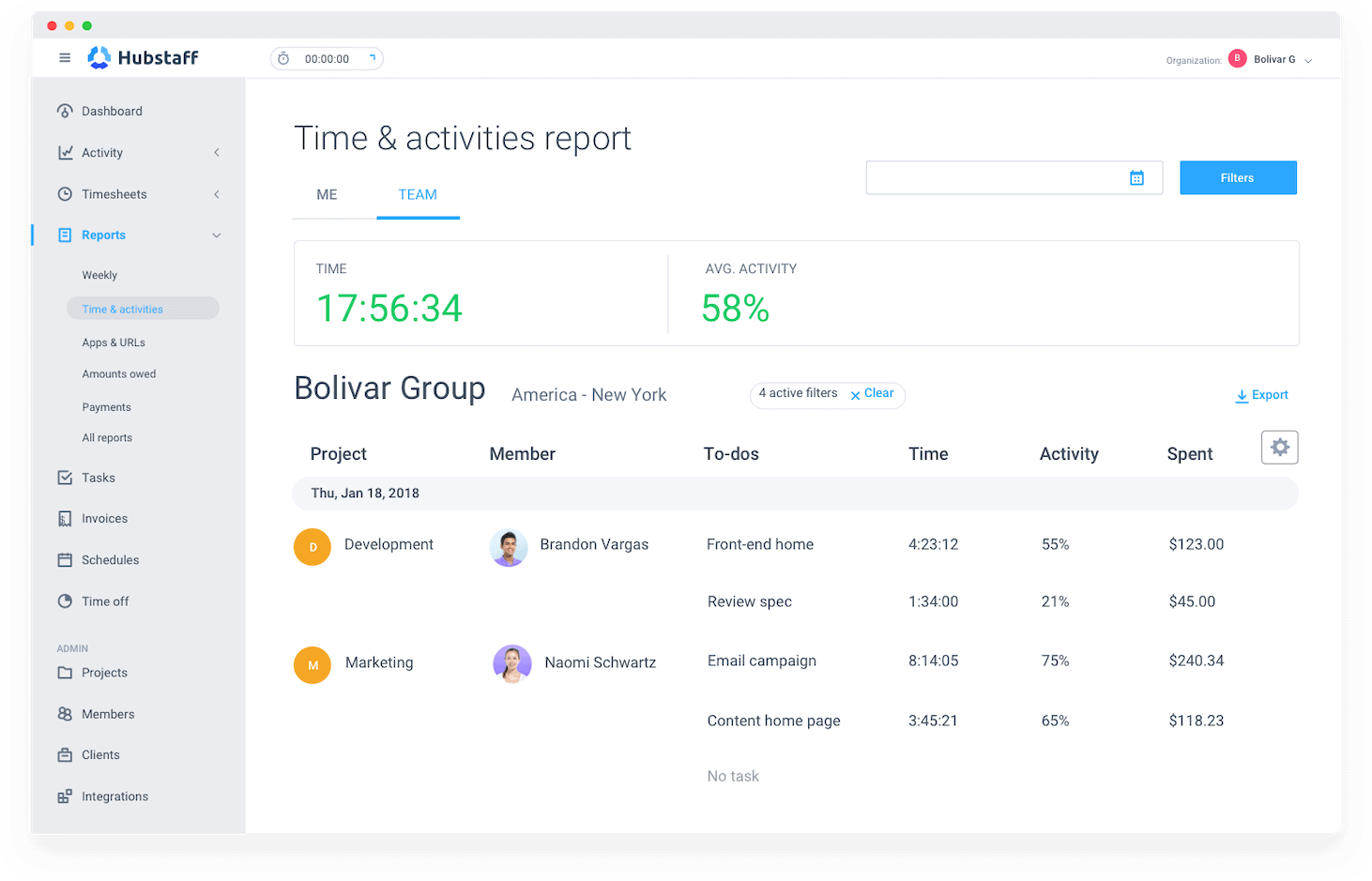There are a lot of situations where scheduling can be a challenge.
Different types of businesses face different obstacles.
If your company works in shifts, It can be tough to balance your business needs and your team’s availability.
Field teams must find the sweet spot between burnout, overtime expenses, and overstaffing their job sites.
Remote companies like Hubstaff face the challenge of scheduling overlapping hours so that teams across multiple time zones can collaborate.
Even if your team always works the same shifts, you still need to manage employee scheduling when people take vacations, sick leave, and other time off.
Employee schedule management is the art of balancing business goals with your team’s availability and well-being. Managers that find long-term success can meet the needs of both their company and their team.
Let’s talk about tips and techniques for efficient employee scheduling.
Boost your team’s efficiency with Hubstaff's productivity tools
Before you start
The employee scheduling methods discussed in this post might not apply to every business. For example, if you operate in an industry or country that’s heavily regulated, you may not be allowed to offer on-call work.
If a section doesn’t apply to you, skip ahead.
Here’s what we’ll cover:
- Analyze and forecast business needs
- Evaluate workforce needs
- Consider employee dynamics
- Recognize the differences between shifts
- Hire when you need to hire
- Promote open communication
- Reward accommodating employees
- Maintain a standby pool if necessary
- Employ bottom-up scheduling technique
- Set scheduling expectations right away
- Formalize your employee scheduling policy
- Publish schedules with plenty of notice
- Use software to track time and manage schedules
- Addressing scheduling abuse
14 techniques and tips for employee scheduling
1. Analyze and forecast business needs
There are two ways to figure out what your business needs. First, look back on what you’ve needed in the past. Then, look ahead to what you expect you’ll need given the current state of your business.
It sounds easy to do, but it’s also easy to overlook. Have you ever felt like the busy season snuck up on you?
This is easier when you use software to help manage your team schedule. If you still use paper calendars, you’ll miss important things.

Here are some of the things to think about:
Seasonality
Every business has at least a little bit of seasonality, but for some, the difference is drastic. Plan ahead if you need to staff up during the busy season.
When things get busy, you may need more coverage.
Some businesses have seasonal positions, though, like dedicated restockers when your existing team doesn’t have time to manage inventory.
Decide if it’s wise to hire people for a seasonal position or try to make up the difference with your existing staff.
During major holidays, expect more time-off requests from your team, too. How will you handle an increase in vacation requests? If time off is more limited because major holidays are busy, let your team know way ahead of time so they can plan accordingly.
External factors
On top of your business’s seasonality, your staffing needs can change with external factors.
During the summer, some team members may need to work different shifts to take care of children home from school. This is also a popular time for vacations and trips.

Allergy season and flu season can cause short-term staffing challenges as people aren’t well enough to come to work. Some businesses can adjust, but others need a strategy to make sure there are people available to cover a missed shift.
Outside circumstances can be unpredictable, but they often follow seasonality trends just like your business cycle.
Look at your data from the previous year. When did people request the most time off? When did you need to make the most scheduling adjustments? Try to identify patterns so that you’re not caught off guard this year.
Business events
Are you planning on launching a new product line this year?
Is your company having a big sale to draw in more customers during the slow season?
Major sales and business initiatives take months of planning and work. This gives you lots of time to make adjustments to your employee schedules.
Events can impact your customer demand and the availability of internal resources. If your top performers will need to focus their time elsewhere, for example, you know you need to adjust other peoples’ shifts to pick up the slack.
2. Evaluate workforce needs
Plenty of managers assume employees will work the hours they assign them without pushback. The truth is, scheduling employees to work extra hours when they are unable or unwilling could eventually lead to conflict.
You might be able to force someone to complete a shift in the short term. But over time, you will likely damage morale and limit your team’s productivity.
The discomfort can cause high turnover as your team members look for more manageable work arrangements.

Instead, respect both their needs at work and their time away. Ask them about their availability and circumstances. Some people want to take on more shifts, and some have other obligations that they need to consider first.
When you know who wants more shifts and who would rather not pick up extra time unless they have to, it’s easier to fill little scheduling gaps.
3. Consider employee dynamics
When you ask your team about their availability, also ask about their ideal working conditions.
People aren’t robots. We all have preferences about leadership styles, coworker personalities, and working hours. These factors affect productivity. It’s easier to do your best work when the circumstances are comfortable for you.
If it’s practical for your business model, consider allowing some of your team to work from home. After all, remote work can boost productivity. This is a great option when on-site interruptions keep getting in the way of your to-do list.
The premier remote team time tracking tool
Help your remote teams track time with the full-featured 14-day free trial

Also, try experimenting with different shift combinations. Employees who like each other may work more productively together. However, they could also distract each other if they’re more inclined to socialize than to work.
At the same time, some people have personality conflicts that make it hard to work together. Watch out for pairings that bring out the worst in each other.
If you can, match team members with the right manager. A tough manager might motivate some to do their best work, but cause resentment in others. You’ll get the best results if you match work styles with management styles.
Ultimately, you still need to balance team dynamics with the needs of your business as a whole. It’s difficult but worth the effort.
4. Recognize the differences between shifts
One shift is not equal to another. There are different responsibilities for opening, closing, and prepping for different times of the day. Some shifts are busier, and some are likely to bring in better tips.
Sometimes, you need specific people at specific times. Businesses that handle a lot of cash need someone trustworthy to count out the register at the end of the day, for example.
Think about that scenario for a second.
If you don’t have enough team members that you trust to handle cash, you’re either going to work a lot of nights or ask your most trustworthy employees to stay late often. They may burn out faster or go work somewhere else where they have more scheduling flexibility.
Situations like that are why it’s so important that you understand the needs of each shift.
Make sure that you can cover those needs with your existing staff. If you can’t, either hire more help or train your existing team members so they can reliably cover different shifts.
5. Hire when you need to hire
Hiring isn’t the same thing as scheduling, but they’re closely related.
Shift work presents some unique hiring challenges.
If you hire too many people, you may not have enough hours for everyone to earn what they expect.
Being short-handed is just as problematic. You’ll rely on your best team members more heavily, which leads to exhaustion and resentment. As overworked employees quit, you’ll have to train new people while under extreme pressure to meet business needs.
As you look at your schedule for the next few weeks or months, you might notice some gaps. Here’s how to decide whether to fill them with another team member.
When to hire
If you answer these questions with a “yes,” then consider putting up a job posting.
- Do you have the budget to support a part-time or full-time team member?
- Are your existing team members already working more than 40 hours every week?
- Would it be cheaper to pay a new employee than it is to pay overtime?
- Does your team lack some skills that would make their job easier and more efficient?
- Are you expecting your staffing needs to increase in the next 60 days?
You might be on the fence about some of these questions. Maybe you definitely need more help, but your staffing needs are inconsistent, so you’re not confident you can give someone enough hours to keep them around every week.
In situations like this, consider hiring for an on-call position. We’ll talk more about this later.
6. Promote open schedule communication
A lot of irritating business issues — missed shifts, arguments, and incomplete tasks are just a few — come from communication breakdowns.
You can solve a lot of problems by teaching your team how to communicate. When you do, you’ll find that people bring up issues sooner, work better together, and argue less when you ask for more help.
This openness builds trust and ensures team members have the confidence to share their work preferences with you without fear of ridicule.

Remember, communication goes both ways. If your team does a poor job sharing information, you probably have some things to work on, too.
Use this in-depth guide to work on your communication skills. In the meantime, here are some tips.
- Post information publicly. Whether you’re sharing the upcoming employee schedule or news about a new seasonal promotion, make sure that everyone on the team has access.
- Respect the team’s off hours. You might be tempted to call someone at home to ask where they left the stapler or what they plan to do with that new shipment of inventory, but it’s rarely worth the invasion into their private time. In almost every case, you can answer a question yourself or wait until that person’s next shift.
- Create a space for anonymous feedback. It’s hard to be honest with the boss, especially if you feel like you’re easy to replace. Build trust with your team by listening to feedback anonymously and acting on it. When they see that you value their opinions, your team will be more comfortable talking to you directly.
- Keep your cool. If someone comes to you with a concern and you react negatively, they’ll never be honest with you again. Neither will anyone else who saw how that situation unfolded. Thank your team for their openness and act like you appreciate it.
7. Reward accommodating employees
By respecting employees’ work preferences and asking them for their input, you can increase morale. However, there will still be moments when the needs of the business and team member preferences do not align.
Asking reluctant members of the team to work different or extra hours can be challenging. For better results, be humble and appreciative when asking them to make that sacrifice. Attitude is everything.
Entice them with rewards (overtime pay, days in lieu, etc.) and be generous with your praise. They may even volunteer to help in a future scheduling crisis.
8. Maintain a standby pool if necessary
Even with an open dialogue and incentives, finding employees to work undesirable shifts can still be challenging. If your business experiences high turnover or irregular hours, one solution could be a standby pool.
The people in your standby pool are like substitutes. They fill in if your regular staff is unavailable.
The standby pool can come from team members who have expressed interest in taking extra shifts, from people hired for on-call work, or both.
On-call employees agree to be available during specific hours, but only work if you call them in.
If you want to leverage on-call scheduling to fill in some of your staffing gaps, be very clear about what you’re looking for. There are people who seek out these kinds of arrangements because it fits well with their other commitments. However, people who expect a part-time position may feel exploited.
The best part? This method eliminates the need to ask reluctant employees to work a different schedule.
Keep in mind that preserving workplace morale can be expensive. Consult your existing team members first to see if they want those extra hours. Then, if they decline, you can reach out to the people who work on-call only.
9. Employ bottom-up scheduling technique
If you already have great trust and communication in your team, bottom-up management (or bottom-up scheduling) saves time when planning work timetables.
Of course, you will need to check their recommendations against other factors. Do the hours they want to work match up with the business’ needs? Is the team member contractually obligated to fulfill a shift they are trying to avoid?
Even in the best teams, this scheduling technique is prone to abuse. People may try to schedule themselves for all the shifts with the best tips or avoid shifts that require more effort.
For these reasons, don’t use a bottom-up approach exclusively.
There will be times when you have to put your foot down, but using this team-driven method as often as possible can reduce some early scheduling headaches. Plus, people are more willing to work less desirable shifts when they feel like they’ve had a say in that scheduling decision.
10. Set scheduling expectations right away
If you want your staff to work on a rotating schedule, they should know that from the day they are hired. The same thing applies to on-call work, overtime policies, and other scheduling restrictions.
As your business grows, you might need to make changes. Announce and explain those adjustments as soon as you can.
Talk about changes in your monthly all-hands meetings. If you anticipate events that will require a group to switch up their hours, inform them in advance. Use your scheduling software to share announcements and publish your policy.
That brings us to the next tip.
11. Formalize your employee scheduling policy

For employees to honor the rules and processes you put in place, you’ll need to hold yourself accountable too. If you expect employees to respect your time, you’ll need to respect theirs as well.
Here are some of the questions your policy should answer:
- How do you choose which team members work the most popular shifts?
- What is your time-off policy?
- Can employees switch shifts, and does it require manager approval?
- Are there restrictions on overtime?
- How do you track time worked?
12. Publish schedules with plenty of notice
It’s not enough to publish work timetables and expect your team to take it from there.
Give the team plenty of time to see the schedule, make arrangements to accommodate it, and challenge it if necessary.
When you give people time to respond, they can raise issues early and work together to find a schedule that works for everyone. Waiting until the last minute only generates conflict.
13. Use software to track time and manage schedules
Scheduling on paper is inefficient and prone to errors.
Plus, if you use a paper schedule, you have to manually hand it out to everyone. If there are changes, some people might not realize until they’ve already missed a shift.

Team management software is easy to use and cost-effective. It’s well worth using a good tool to get things done faster and with fewer headaches.
Hubstaff can help you plan shifts, manage time-off requests, and notify your team members of scheduling changes automatically.
On top of setting and communicating your schedule, great software like Hubstaff can:
- Automatically generate time and attendance reports
- Communicate the tasks you want each person to do during their shift
- Track time off balances
- Handle clock-ins and clock-outs
- Generate timesheets
- Issue paychecks
Ideally, your system should help generate unbiased proof of work. Punch cards and other manual tools have been staples of time tracking for ages. However, that doesn’t mean they aren’t error-prone and outdated.
For example, a construction worker might forget to punch out because he is rushing to pick his kids up from school. Revisiting this situation after the fact can lead to inaccuracies and disagreements about the hours in question.
Fortunately, productivity management tools like Hubstaff can help companies avoid this issue. For example, Hubstaff’s Geofencing technology allows field teams to clock in and out as soon as they enter or leave the radius of a Job site.

If your crew works remotely, the intuitive timesheets feature helps teams clock in and out with the click of a button. Hubstaff can also help team leads optimize scheduling by assessing the days and times that their employees are most productive.

Automation like this can solve a lot of scheduling challenges. Plus, it handles a lot of back-office tasks for you so you can use your time for more productive things.
Streamline timekeeping and payroll
Pay your team members on time and precisely what you owe them.

14. Addressing scheduling abuse
Creating a happier and more collaborative workplace will reduce the likelihood of employees lying about the number of hours they’ve worked. But that doesn’t mean it won’t happen from time to time.
This is called time theft, and it’s an expensive problem — it costs an estimated $50 million every year. It’s one of the issues that Hubstaff was designed to address.
Other types of scheduling abuse, both from your team and from management, can create tension in your team.
Companies can abuse on-call scheduling to save money at the expense of their employees’ livelihoods. Team members can use bottom-up scheduling or time-off requests to avoid shifts they don’t want to work and put more strain on team members who are more cooperative.
Be honest with yourself. Are you or your team members abusing your current scheduling system?
Aim to create a fair, unbiased system that rewards the right things. Your business will run more smoothly and your team will appreciate it, too.
Clocking out: our final thoughts
Implementing any one of these team member scheduling tips is a step in the right direction. Pick and choose the things that apply to you right now, and bookmark this post to come back to it when you’re ready for the next step.
With every new schedule you devise, you will:
- Prioritize business goals and keep your organization up-to-date
- Invite employer-employee collaboration to optimize schedules
- Implement proof of work and time tracking technology to maximize productivity
When it comes to employee scheduling, the possibilities are endless. Share your preferred techniques in the comments to inspire other leaders to improve their scheduling methods.
For further advice about managing your teams, check out these articles:
Most popular
The Fundamentals of Employee Goal Setting
Employee goal setting is crucial for reaching broader business goals, but a lot of us struggle to know where to start. American...
Data-Driven Productivity with Hubstaff Insights: Webinar Recap
In our recent webinar, the product team provided a deep overview of the Hubstaff Insights add-on, a powerful productivity measurem...
The Critical Role of Employee Monitoring and Workplace Security
Why do we need employee monitoring and workplace security? Companies had to adapt fast when the world shifted to remote work...
15 Ways to Use AI in the Workforce
Whether through AI-powered project management, strategic planning, or simply automating simple admin work, we’ve seen a dramatic...




